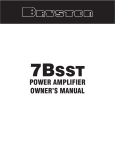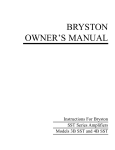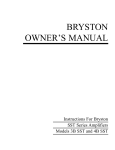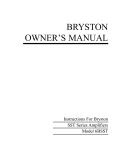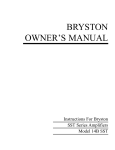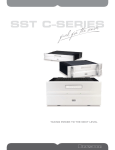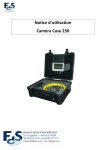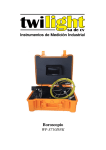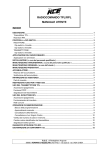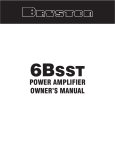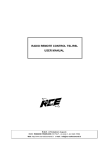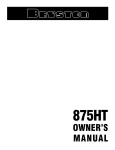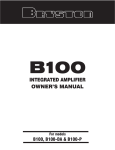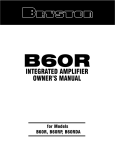Download Bryston 7B SST User's Manual
Transcript
BRYSTON OWNER’S MANUAL Instructions For Bryston SST Series Amplifiers Model 7B SST 7B SST Series Amplifier Table of Contents General Introduction Description Installation and Ventilation Page 1 Rear Panel Input Settings/Connections Setting Input Selector Switch Balance Input Connector Configuration Setting Input Sensitivity Page 2 Output Binding Posts Page 3 Front Panel Description LED Indicator (Power-up Sequence) LED Indicator (Operating Conditions) Page 4 Power Control Panel Master Circuit -Breaker AC Power Input Local/Auto Switch Local/External Switch Page 5 Block Diagrams Page 8 Typical Performance Graphs Page 9-12 Technical Specifications Page 13 Important Warranty Information Back Cover 7B SST Series Amplifier Introduction Thank you for choosing the 7B SST SERIES mono block Power Amplifier. Bryston welcomes any suggestions you may have, or comments regarding the operation of your amplifier. We consider you, our customer, to be Bryston’s most important resource, and your opinion is very much appreciated. Description 7B SST The 7B SST is a single channel mono 600 Watt audio power amplifier. The 7B SST selects a balanced or single ended input and a gain of 29dB(1v) or 23dB(2v) may be selected. The 7B SST includes ‘soft start’ power control circuitry to eliminate high inrush currents when A/C power is applied. The power up or turn-on of the 7B SST may be activated by a remote control voltage 4v to 12v ac or dc. Warranty ( see back page for details ) Shipping Box & Packing Material Please keep the original shipping box and all packing material. This will ensure the amplifier is protected in future transport. In the unlikely event you have a problem and must return it for service you must use the proper packing material. Ship the amplifier only in the original packing material, as the unit is not insurable by carriers otherwise. Installation ( see rack mounting section if applicable ) Ventilation. The most important installation consideration is ventilation. The 7B SST amplifier is convection cooled. Unrestricted air-flow across the 7B SST heat sinks is a must. For this reason do not install anything directly above it. Allow 3.5’ (2u) to 5” (3u) inches of space above and to the sides of this amplifier. Do not install directly above other heat generating equipment. Should your instillation conditions be constricted, then additional forced air-cooling may be necessary. Bryston can provide an optional fan package if required. Thermal shut down during operation indicates insufficient air flow, and a remedy must be found for cooling the amplifier. Provide a minimum 6” space to the rear of the amplifier for ventilation and dressing cables to and from the amplifier. Never operate the amplifier in a vertical position. Wiring the SST amplifier ( also see rear panel description ) Speaker wires should be as short as practical. Use quality wire, and if runs are more than 3 meters use at least 12 gage wire. The speaker binding posts will accept wire up to 3 gage in size. Bryston offers speaker cables and amp interconnects for your application. Check our website under products/cables (www.bryston.ca) for more information. A/C power Before plugging in the power cord be sure your 7B SST amplifier is specified for the correct a/c voltage for your locality. The voltage is listed on the label found at the upper right of the rear panel. The circuit feeding the 7B SST should be sufficient so as not to cause the circuit breaker to trip (15 amp min). Note: the 7B SST when delivering maximum power into a 4 ohm load, will consume all the available power in a normal household circuit, therefore a dedicated electrical circuit may be necessary with this situation. Never lift the safety ground to the amplifier nor remove the ground pin from the plug. Power line conditioners will not improve the 7B SST amplifier performance, in fact most of the time they restrict the flow of current to the amplifier, reducing performance at higher output levels 1 7B SST Series Amplifier Rear Panel Input / Output Connections PUSH 1. Input Select Switch. Each SST channel gives the user the option of switching between either balanced input or single ended input. 2. Balanced Input connector. ( Imp. 20k ) This input connector accepts standard ‘XLR’ or 1/4” TRS . Use quality, 100% shielded cables with gold plated connectors. 3. Single Ended Input. ( Un-balanced input ) ( Imp. 50k ) This input connector accepts standard ‘RCA’ or ‘Phono’ connectors. Use quality, 100% shielded cables with gold plated connectors. Balanced input Vs Single ended input: The balanced input requires a balanced pre-amp source. Balanced systems provide noise rejection from external electrical interference, so cable length can be very long ( 50m or longer ). The single ended or unbalanced input is provided for pre-amps without balanced output. Single-ended cables should be kept to 20’ (7m) or less. In general never use longer cables than necessary, never coil excess cable length, and keep signal wires away from AC power or speaker cables. 4. Input Sensitivity (Gain) Switch. The optimum gain setting will depend upon the source pre-amp operating level, and or personal preference. The 1v setting is used when the source is single-ended, or from a transformer coupled balanced source. This is the home theatre setting for single ended or un-balanced operation. The 1v setting provides the most amplifier gain - 29 dB. (1v in = 100w @ 8 ohms.) (noise -110 dB) The 2v setting is used when the sources output is actively Balanced. This is the home theatre setting for balanced operation Or use this setting with any systems where the volume control rotation is limited to the bottom half of the control or less. The 2v setting provides an amplifier gain - 23 dB. ( 2v in = 100w @ 8 ohms.) ( noise -113 dB ) The noise is referenced in dB below rated output. Different input configurations result in slightly different noise readings. The above noise ratings represent minimum readings, actual readings may be better. 5. Level Control. (pro models only) The level control will attenuate the input signal level from 0dB through -14dB. 2 7B SST Series Amplifier 6. Output binding posts. The RED binding post is the in-phase amplifier output. Connect to this post the (+) terminal on the loudspeaker. The BLUE binding post is the inverted-phase amplifier output. Connect to this post the (-) terminal on the loudspeaker. Note: At no time should either output be connected to a ground, or chassis. Failure of the amplifier may result. Never connect either output in parallel with another amplifier. The minimum recommended loudspeaker load is 4 ohms. The Output binding posts provide three different interconnect options. Combinations may be used when bi-wiring. See figure 2 below. Cables should be kept as short as practical and should never be terminated with connectors that may become confused for AC power connectors. Cables should be dressed away from input and power cables. 1. Banana plugs offer a quick disconnect option. Before inserting a banana plug into the binding post be sure to tighten the post nut to avoid rattling and to provide full insertion of the banana plug. Gold plated locking banana plugs are available from Bryston. 2. Spade lugs provide high contact area and secure fastening. Lugs should be gold plated. See diagram for details. Post diameter is 5/16’ ( 8mm ), lug width 5/8” (16 mm). Gold plated spade lugs are available from Bryston. 3. Stripped bare wire up to 3 gage can be inserted through the hole in the binding post and held in place by tightening the post knob. Additional tightening pressure can be achieved using a coin in the slots of the knob. Do not over tighten or the binding post may become damaged. Note that copper wire is malleable and may require further tightening after the initial installation. Fig 2 Spade lug dimensions 3 7B SST Series Amplifier Front Panel 1. 'SST POWER' switch The front panel label 'SST POWER', is a touch sensitive membrane switch used to apply or remove a/c line power to the soft start circuitry. Push firmly the center of the switch until the power-up sequence begins. Push again and the amplifier will power-down. ( Note: the rear circuit breaker must be on for the amplifier to power-up) 2. LED Indicator The 7B SST has an LED indicator to monitor the following conditions: UNLIT indicates the amplifier has no power. RED indicates the amplifier is muted (power-up) GREEN indicates the amplifier operation is normal. FLASHING RED - indicates the amplifier clipping. ORANGE indicates channel thermal shutdown. Power up sequence After pushing the 'SST POWER' switch, the LED will turn from unlit to red (mute). When the power supply has stabilized the amplifier will come out of mute and the LED will change to green (normal operation). Unlit LED ( No power ) The 7B SST LED when unlit indicates no A/C mains power is present and the amplifier probably needs only to be powered on or the rear panel circuit breaker is switched off. Clipping ( flashing red ) Clipping occurs when the channel output level no longer can follow the level increase at the input (Overdriven input condition). When the 7B SST is driven into clipping the LED will change from green to red then back to green when the level is reduced ( Flashing Red ). Momentary clipping can be tolerated, however it indicates that maximum un-distorted power has been surpassed and potential speaker damage may result if overload conditions persist. Any amplifier that is constantly operated into clipping indicates a more powerful amplifier is needed for that application. Thermal Shutdown ( orange ) The 7B SST has thermal shutdown circuitry to prevent damage due to overheating. Should thermal shutdown occur, the amplifier will mute, and the LED will turn orange indicating this condition. When the amplifier has cooled to a safe operating condition the 7B SST will return to normal operation. Persistent Thermal shutdown indicates steps need to be taken to increase airflow across the heat sink. ( Also see installation section on ventilation ). 4 7B SST Series Amplifier Power Control 1. Master circuit - breaker. The 7B SST amplifier uses a magnetic-trip circuit breaker (1) to protect the amplifier. This switch should be ‘OFF’ during installation. When switched ‘OFF’ all A/C power is removed from the amplifier, including standby power. The circuit breaker is not the power switch and should be switched to and left ‘ON’ after the installation is complete. Use the “SST POWER” switch or an external control voltage to Power-up or Power-down the amplifier. Should the breaker trip, lower or remove the amplifier input signal. Switch the breaker to the ‘ON’ position. Then power the unit up normally. The circuit breaker must be ‘ON’ at all times for the 7B SST amplifier to operate. 2 1 2. AC power input. On the rear panel is provided a high current plug for the power cord receptacle. Check that the voltage rating on the label conforms with your locality. With the circuit breaker ‘OFF’ insert the power cord into the 7B SST amplifier, then plug the other end to an appropriate A/C power outlet. 3. Power-Up ( Local / Auto switch. ) A. In “Local” position either the front panel ‘SST POWER” switch or an external voltage controls the power-up of the 7B SST amplifier. B. “Auto” is used when the 7B SST amplifier is powered from a switched power outlet. The ‘SST POWER’ switch and / or control voltage will function normally after the initial power up. 4 3 4. External control voltage power up ( Local / external switch.) A. To power-up the SST amplifier using an external control voltage, Supply a 4v to 12v A/C or DC control voltage to the ‘IN’ terminals of connector ( 5 ). Use paired wire of 22 to 18 gage sufficient in length between the source device and the SST amplifier. (see ‘W’ ) Select switch (4) to “External”. The amplifier will now power-up only when the control voltage is present (on). Immediately following power up, the control voltage will appear at the ’OUT’ terminals of connector (5) for the control of other equipment.The removal of the control voltage (0v) causes the amplifier to turn ‘off’ and the control voltage at the ‘OUT’ terminals is interrupted. B. In the“Local” setting of switch (4) the 7B SST amplifier will ignore the control voltage, and power up only by using the front panel ‘SST POWER’ switch, or as in section 3 above. If a control voltage is present at the ‘IN’ terminals it will still be available at the ‘OUT’ terminals after the power-up sequence. PUSH Control Voltage source 4 to 12v ac or dc fig W Control voltage wire preparation for screw terminals separate 1” RS-232 E X P . 18 to 22 gage wire RISK OF ELECTRIC SHOCK - DO NOT OPEN RISQUE DE CHOC ELECTRIQUE NE PAS OUVRIR SERIALNUMBER SP112VTRIG.OUT OPT1 AUX.IR OPT2 1 2 0 V 60Hz M U T E C ON/OFF F2A250V 20W 1/4” strip to other voltage controlled devices Note: The ‘OUT’ terminals are connected to the ‘IN’ terminals once the 7B SST amplifier has powered-up. The control current is determined by the source equipment. The carrying current of the ‘OUT’ relay is 2 amps. The 7B SST control circuitry itself draws less than 2 mA from the control current when operating. 5 7B SST Series Amplifier MODULE MUTE +/-30Vdc SENSITIVTY AND GAIN MODULE 1 SWITCH +/-65Vdc SINGLE ENDED INPUT DEDICATED HIGH CURRENT POWER SUPPLY REGULATED INPUT LOW SELECT VOLTAGE XLR OR SUPPLY PHONE SWITCH INPUT RED BINDING POST BUFFER POWER AND GAIN AMPLIFIER STAGE OUTPUT (NON INVERTED) INPUT TEMPERATURE +/-30Vdc MONITOR CLIPING AND CURCUIT LED MONITOR SOFT START AC INPUT AND LOGIC CONTROL MODULE MUTE +/-30Vdc MODULE 2 +/-65Vdc DEDICATED HIGH CURRENT POWER SUPPLY REGULATED LOW INVERTER VOLTAGE BLUE BINDING POST POWER AMPLIFIER OUTPUT (INVERTED) SUPPLY +/-30Vdc TEMPERATURE MONITOR CLIPING REMOTE AND TRIGGER CURCUIT ON MONITOR 8 7B SST Series Amplifier Typical Band-pass Noise -50 -60 Power supply artifacts are all below -95 dBu balanced input with 23dB (2v) gain shown -70 -80 d B u -90 -100 -110 -120 dBu: dB relative to a reference of 0.7746 Volts -130 20 50 100 200 500 1k 2k 5k Hz Typical THD+N Harmonic Content +10 +0 -10 d B r -20 -30 The harmonic content of the 7B SST is all even order. A R E F 1 5 0 W -40 -50 -60 -70 8 O H M S -80 -90 -100 -110 -120 10k 20k 30k 40k 50k 60k 70k 80k 90k 100k 110k 120k 130k Hz 9 7B SST Series Amplifier Typical Frequency Response 7BSST +0.5 +0.4 +0.3 +0.2 +0.1 8 ohm 600w +0 -0.1 d B r 4 ohm 900w -0.2 -0.3 A -0.4 -0.5 -0.6 -0.7 -0.8 -0.9 -1 20 50 100 200 500 1k 2k 5k 10k 20k 50k Hz Typical Phase Response +15 +14 +13 +12 +11 +10 +9 +8 d e g +7 4 ohm 900w +6 +5 +4 +3 +2 8 ohm 600w +1 -0 -1 20 50 100 200 500 1k 2k 5k 10k 20k Hz 10 7B SST Series Amplifier Typical THD+N Sweep 0.01 0.009 0.008 0.007 0.006 % 0.005 Graph shows that distortion is essentially unaffected by load. 2v balanced input shown. 0.004 0.003 4 ohm 900w 0.002 0.001 8 ohm 600w 0 20 50 100 200 500 1k 2k 5k 10k 20k Hz Typical IMD Sweep 0.01 0.009 0.008 0.007 0.006 % 0.005 0.004 0.003 4 ohm 900w 0.002 8 ohm 600w 0.001 0 2k 3k 4k 5k 6k 7k 8k 9k 10k 20k Hz 11 7B SST Series Amplifier Damping Factor 800 750 700 650 600 550 500 450 D F 8 ohm reference 400 350 300 250 200 150 100 50 0 20 50 100 200 500 1k 2k 5k 10k 20k Hz 12 7B SST Series Amplifier Technical Specifications Power Output 600 watts per channel into 8 ohms 900 watts per channel into 4 ohms Gain Select and Sensitivity 29dB - 2.3Vin = 600W @ 8 Ohms - (1V Position) 23dB - 4.6Vin = 600W @ 8 Ohms - (2V Position) Input Impedance 50 Kohms single ended 20 Kohms balanced Distortion IM or THD+noise < 0.005% 20Hz to 20kHz at 600 watts into 8 W < 0.007% 20Hz to 20kHz at 900 watts into 4 W Noise Measured with input shorted - 20Hz to 20kHz. >110dB below rated output 29dB gain (- 75dBu) >113dB below rated output 23dB gain (- 78dBu) Slew Rate > 60 volts per microsecond Power Bandwidth < 1 Hz to over 100 kHz Damping Factor Over 300 at 20 Hz, ref. 8 ohms Dimensions - L x H x D 19” version with handles 48.3 x 13.3 x 32cm - 19” x 5.25” x 15.75“ mounted rack depth - 28cm - 11.0" 17” version 43.2 x 13.3 x 28cm - 17” x 5.25” x 11“ Weight: approx. 22kg - 50 lbs Power Consumption & Heat Load At Idle Max. Heat Dissipation - 215 Watts 733 Btu/Hr. output @ 600W @ 8 ohms Max. Heat Dissipation 8 ohms - 1284 Watts 2333 Btu/Hr. output @ 900W @ 4 ohms Max. Heat Dissipation 4 ohms - 1980 Watts 3684 Btu/Hr. 13 BRYSTON 20 -YEAR WARRANTY Bryston products are warranted to be free from manufacturing defects for a minimum of twenty years from the original date of manufacture. This includes parts, labour and return shipping to the first owner and all subsequent owners. Warranty coverage is automatic and commences with the original date of manufacture which is kept on file at Bryston. In the event of a defect or malfunction, Bryston will remedy the problem by repair or replacement, as we deem necessary, to restore the product to full performance. This warranty is considered void if the defect, malfunction or failure of the product or any component part was caused by damage ( not resulting from a defect or malfunction ) or abuse while in the possession of the customer. Tampering by persons other than factory authorized service personnel, or failure to fully comply with Bryston operating instructions, voids the warranty. This warranty gives you specific legal rights and you may also have other rights which may vary from province to province and country to country. BRYSTON SERVICE CANADA: 24 STEINWAY BLVD., UNIT 48 ETOBICOKE, ONTARIO CANADA M9W 6T8 PHONE: 416-675-2585 FAX: 416-675-3103 BRYSTON LTD. P.O. BOX 2170 677 NEAL DRIVE PETERBOROUGH, ONTARIO CANADA K9J 7Y4 BRYSTON SERVICE U.S.A.: 70 COVENTRY ST. SUITE #5 NEWPORT VERMONT. U.S.A. 05855 PHONE: 802- 334-1201 FAX: 802-334-6658 FOR BRYSTON SERVICE OUTSIDE CANADA: CONTACT YOUR LOCAL DISTRIBUTOR OR CHECK OUR WEB SITE AT: [email protected] OR CALL BRYSTON DIRECTLY AT: PHONE: 705-742-5325 FAX: 705-742-0882














